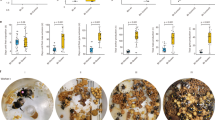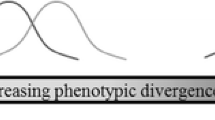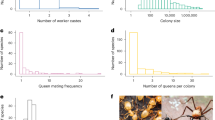Abstract
In the Origin of Species, Darwin discussed several challenges that worker insects presented to his theory of natural selection. Complex instincts such as building of combs of hexagonal cells were one problem and were explained by showing plausible intermediate stages. A more serious challenge was posed by the multiple worker castes seen in many ants. How could sterile individuals continue to evolve? A careful reading of the Origin suggests that Darwin was not primarily concerned by the evolution of worker sterility itself, which he considered a minor difficulty. Some modern commentaries on Darwin and insect workers seem to be cases of present interests interfering with the interpretation of the past. From a modern perspective, the evolution of a worker caste, and its corollary altruism, are evolutionary puzzles inasmuch as natural selection normally favors greater, not lesser, individual reproduction. These puzzles were resolved by Hamilton's theory of inclusive fitness. We now have a good functional understanding of how natural selection can cause both the origin of workers and their elaboration into greater levels of sterility and multiple morphological castes. Mechanistic understanding of morphological castes is also increasing via research into alternative developmental pathways. When the Origin was written, genetics did not exist and it would have been virtually impossible for Darwin to elaborate such ideas. However, the Origin probably addressed the main questions in the minds of Victorian readers in relation to insect workers. Darwin was prescient in having insights with close relationships to modern-day interests and the key principles involved, including kinship and benefits to the colony, even if these are not exact precursors to modern thinking.


Similar content being viewed by others
References
Alcock J (2001) The triumph of sociobiology. Oxford University Press, Oxford
Alexander RD (1979) Darwinism and human affairs. University of Washington Press, Seattle
Beekman M, Ratnieks FLW (2003) Power and reproduction in insect societies. Phil Trans Roy Soc Lond B 258:1741–1753
Bourke AFG, Ratnieks FLW (1999) Kin conflict over caste determination in social Hymenoptera. Behav Ecol Sociobiol 46:287–297
Charnov EL (1978) Evolution of eusocial behavior: offspring choice or parental parasitism? J Theor Biol 75:451–465
Cronin H (1991) The ant and the peacock. Cambridge University Press, Cambridge
Crozier RH (2008) Advanced eusociality, kin selection and male haploidy. Aust J Entomol 47:2–8
Darwin C (1859) On the origin of species by means of natural selection. John Murray, London
Darwin C (1871) The descent of man, and selection in relation to sex. John Murray, London
Dawkins R (1976) The selfish gene. Oxford University Press, Oxford
Dietemann V, Hölldobler B, Peeters C (2002) Caste specialization and differentiation in reproductive potential in the phylogenetically primitive ant Myrmecia gulosa. Ins Soc 49:289–298
Dijkstra MB, Nash DR, Boomsma JJ (2005) Self-restraint and sterility in workers of Acromyrmex and Atta leafcutter ants. Ins Soc 52:67–76
Dugatkin LA (1997) Cooperation among animals: an evolutionary perspective. Oxford University Press, Oxford
Dugatkin LA (2006) The altruism equation: seven scientists search for the origins of goodness. Princeton University Press, Princeton
Dyer FC (1992) The biology of the dance language. Annu Rev Entomol 47:917–949
Foster KR (2009) A defense of sociobiology. Cold Spring Harbor Symp Quant Biol 74:1–16
Foster KR, Wenseleers T, Ratnieks FLW (2006a) Kin selection is the key to altruism. Trends Ecol Evol 21:57–60
Foster KR, Wenseleers T, Ratnieks FLW, Queller DC (2006b) There is nothing wrong with inclusive fitness. Trends Ecol Evol 21:599–600
Hamilton WD (1964) The genetical evolution of social behaviour I & II. J Theor Biol 7:1–52
Hamilton WD (1972) Altruism and related phenomena, mainly on social insects. Annu Rev Ecol Syst 3:193–232
Hasegawa E (1997) The optimal caste ratio in polymorphic ants: estimation and empirical evidence. Am Nat 149:706–722
Heinze J, Foitzik S, Oberstadt B (1999) A female caste specialized for the production of unfertilized eggs in the ant Crematogaster smithi. Naturwissenschaften 86:93–95
Helanterä H, Ratnieks FLW (2008) Geometry explains the benefits of division of labour in a leafcutter ant. Proc Roy Soc Lond B 275:1255–1260
Herbers J (2009) Darwin's ‘one special difficulty’: celebrating Darwin 200. Biol Lett 5:214–217
Hölldobler B, Wilson EO (1990) The ants. Harvard University Press, Cambridge
Hölldobler B, Wilson EO (2009) The superorganism: the beauty, elegance, and strangeness of insect societies. Norton, New York
Hughes WOH, Oldroyd BP, Beekman M, Ratnieks FLW (2008) Ancestral monogamy shows kin selection is key to the evolution of eusociality. Science 320:1213–1216
Hunt JH (2007) The evolution of social wasps. Oxford University Press, Oxford
Lewens T (2007) Darwin. Routledge, London
Malécot G (1948) Les mathématiques de l'hérédite. Masson et Cie, Paris
Marshall J, McNamara J, Houston A (2010) The state of Darwinian theory. Behav Ecol Sociobiol. doi:10.1007/s00265-010-1121-y
Maynard-Smith J (1964) Group selection and kin selection. Nature 201:1145–1147
Møller A, Jennions MD (2002) How much variance can be explained by ecologists and evolutionary biologists? Oecologia 132:492–500
Nowak MA, Sigmund K (2005) Evolution of indirect reciprocity. Nature 437:1291–1298
Nowak MA, Tarnita CE, Wilson EO (2010) The evolution of eusociality. Nature 466:1057–1062
Oster GF, Wilson EO (1978) Caste and ecology in the social insects. Princeton University Press, Princeton
Ratnieks FLW (1988) Reproductive harmony via mutual policing by workers in eusocial Hymenoptera. Am Nat 132:217–236
Ratnieks FLW (2001) Heirs and spares: caste conflict and excess queen production in Melipona bees. Behav Ecol Sociobiol 50:467–473
Ratnieks FLW (2006) The evolution of cooperation and altruism: the basic conditions are simple and well known. J Evol Biol 19:1413–1414
Ratnieks FLW, Helanterä H (2009) The evolution of extreme altruism and inequality in insect societies. Phil Trans Roy Soc Lond B 364:3169–3179
Ratnieks FLW, Wenseleers T (2005) Policing insect societies. Science 307:54–56
Ratnieks FLW, Wenseleers T (2008) Altruism in insect societies: voluntary or enforced? Trends Ecol Evol 23:45–52
Ratnieks FLW, Monnin T, Foster KR (2001) Inclusive fitness theory: novel predictions and tests in eusocial Hymenoptera. Annales Zoologici Fennici 38:201–214
Ratnieks FLW, Wenseleers T, Foster KR (2006) Conflict resolution in insect societies. Annu Rev Entomol 51:581–608
Seeley TD (1995) The wisdom of the hive. Harvard University Press, Cambridge
Shellman-Reeve J (1997) The spectrum of eusociality in termites. In: Choe JC, Crespi BJ (eds) Social behaviour in insects and arachnids. Cambridge University Press, Cambridge
Trivers R (1985) Social evolution. Benjamin/Cummings, Menlo Park
Wenseleers T, Ratnieks FLW (2004) Tragedy of the commons in Melipona bees. Proc Roy Soc Lond B 271:S310–S312
Wenseleers T, Ratnieks FLW (2006) Enforced altruism in insect societies. Nature 444:50
Wenseleers T, Ratnieks FLW, Billen J (2003) Caste fate conflict in swarm-founding social Hymenoptera: an inclusive fitness analysis. J Evol Biol 16:647–658
Wenseleers T, Hart AG, Ratnieks FLW (2004) When resistance is useless: policing and the evolution of reproductive acquiescence in insect societies. Am Nat 164:E154–E167
Wenseleers T, Gardner A, Foster KR (2010) Social evolution theory: a review of methods and approaches. In: Székely T, Moore AJ, Komdeur J (eds) Social behaviour: genes, ecology and evolution. Cambridge University Press, Cambridge
West SA, Griffin AS, Gardner A (2007) Social semantics: altruism, cooperation, mutualism, strong reciprocity and group selection. J Evol Biol 20:415–432
West-Eberhard MJ (1996) Wasp societies as microcosms for the study of development and evolution. In: Turillazzi S, West-Eberhard MJ (eds) Natural history and evolution of paper wasps. Oxford University Press, Oxford
Wheeler WM (1926) Ants: their structure, development and behavior. Columbia University Press, New York
Wheeler D (1986) Developmental and physiological determination of caste in social Hymenoptera: evolutionary implications. Am Nat 128:13–34
Williams GC (1966) Adaptation and natural selection. Princeton University Press, Princeton
Williams GC (1993) Hard-core Darwinism since 1859 (book review of The ant and the peacock [Cronin 1993]). Q Rev Biol 68:409–412
Wilson EO (1971) The insect societies. Harvard University Press, Cambridge
Wilson EO (1975) Sociobiology: the new synthesis. Harvard University Press, Cambridge
Wilson EO (2008) One giant leap: how insects achieved altruism and colonial life. Biosciences 58:17–25
Wilson EO, Hölldobler B (2005) Eusociality: origin and consequences. Proc Nat Acad Sci USA 102:13367–13371
Wynne-Edwards V (1962) Animal dispersion in relation to social behaviour. Oliver & Boyd, Edinburgh
Acknowledgements
We thank the Wissenschaftskolleg zu Berlin (Institute for Advanced Studies, Berlin) for providing us with the opportunity to think about Darwin and social insects, and to lay the groundwork for this article. The WiKo also gave us the opportunity to work alongside Bernard Wasserstein and other eminent historians, whose presence gave us the inspiration to initiate a project with a historical flavor. By restricting ourselves mainly to quotations from the Origin, we hope that this article will not meet with their disapproval. We thank James Marshall for inviting us to contribute to Darwin 200 and for his encouragement and comments. We dedicate this article to the late Ross Crozier, who sadly left us in Charles Darwin's bicentenary year.
Author information
Authors and Affiliations
Corresponding author
Additional information
Communicated by Guest Editor J. Marshall
This contribution is part of the Special Issue “Mathematical Models in Ecology and Evolution: Darwin 200” (see Marshall et al. 2010).
Appendix theory…and query
Appendix theory…and query
The underlying theory for understanding the conditions under which natural selection will favor the evolution of social acts that affect the lifetime reproduction of actors was developed by Hamilton (1964). Recent discussions of social evolution theory include Foster (2009) and Wenseleers et al. (2010). See also Marshall et al. and other contributions to this Darwin 200 collection of papers.
Selfish and mutualistic/cooperative acts do not present a Darwinian puzzle as both increase the lifetime fitness of actors (Ratnieks 2006; West et al. 2007). Altruism, which by definition causes reduced lifetime reproduction, is, however, a Darwinian puzzle inasmuch as natural selection normally favors only traits that increase an individual's reproduction. Hamilton's theory of inclusive fitness, sometimes referred to as kin selection (Maynard-Smith 1964), shows how traits that reduce lifetime production of offspring can be favored by natural selection when help is directed to kin. How closely related actor and recipient need to be depends upon the cost to the actor's reproduction versus the benefit to the recipient's reproduction, and is summarized in Hamilton's rule (rb > c, see also main text). Where costs and benefits are equal, the minimum ratio of relatedness to the recipient required is 1. That is, the altruist must be as related to the collateral kin helped as to its own offspring. This equality is provided in a family in which altruists help rear full siblings instead of offspring or in a clonal society. Note that clonal reproduction does not provide a greater incentive for altruism as the relatedness ratio is also 1 (1:1), the same as for diploid (0.5:0.5) and haplodiploid (0.5:(0.75 + 0.5)/2) family groups with a single parent of each sex. At the level of genes and population genetics, it is easy, in general terms, to see how helping kin at a cost to one's own reproduction can be favored by natural selection. Helping results in fewer of the altruist's genes being passed on directly, but more being passed on indirectly, leading to an overall increase in the frequency of genes that cause altruism.
Social insects have an important relationship with Hamilton's theory of inclusive fitness. On the one hand the altruism of insect workers is the defining characteristic of the eusocial insects. Reproduction in insect societies has provided important tests of inclusive fitness theory itself (see examples in Foster et al. 2006a, b) and the theory has predicted novel features of reproductive and social biology such as queen-worker conflict over sex allocation and worker policing (the mutual inhibition of reproduction by workers) (Ratnieks et al. 2001; Ratnieks et al. 2006).
Over the past few years the importance of Hamilton's theories in understanding insect social evolution have been questioned by the distinguished ant biologist and sociobiologist Edward O. Wilson and colleagues (Nowak et al. 2010; Wilson 2008; Wilson and Hölldobler 2005). These criticisms are wide ranging, and many have been responded to (e.g., Foster et al. 2006a,b; Crozier 2008; Foster 2009). Here, we address a few that are of relevance in the context of this paper.
Wilson (2008) writes “Virtually all of it [research on social insects] has been guided by the concept of group selection, in other words, selection that targets traits emerging from the interaction of colony members [p. 22].” It is true that much research on social insects can be guided by the general and readily apparent fact that workers normally work together for the good of the colony, and can seek explanations for much of what goes on in an insect society on this basis. Observation of any insect colony will readily show examples of cooperation (Ratnieks et al. 2006), such as communication and coordination in defense, nest building and foraging (Dyer 1992; Seeley 1995). What is less obvious to the casual observer is that insect societies are also subject to conflict among nestmates (Ratnieks 2006). By virtue of the intermediate levels of relatedness found in families, the individuals in insect societies are subject to strong altruistic and selfish incentives. They also have opportunities for both altruism and selfishness.
Inclusive fitness theory helps us to understand these opposing tendencies towards altruism and selfishness and their diverse outcomes. The application of the theory is not entirely straightforward (Ratnieks and Wenseleers 2008). One of the main complications comes from the fact that several “forces” normally act at one time. Thus, the level of altruism (the proportion that do not lay eggs) seen in the workers in a colony is affected by multiple factors. One is the direct effect of relatedness on the tendency towards acting altruistically. Another is the effect of relatedness on the tendency for workers to prevent each other from reproducing. Both are significant and yet they work in opposite directions (Wenseleers and Ratnieks 2006; Ratnieks and Wenseleers 2008). High relatedness directly favors altruism. Conversely, low relatedness favors altruism indirectly, by favoring the mutual policing of worker reproduction thereby causing reduced worker production of males.
Where it is the main relevant variable, the predictive power of relatedness can be very high. In queenless colonies the proportion of workers that act altruistically (do not have active ovaries and so are not laying eggs) increases with worker-worker relatedness as expected from Hamilton's rule. This one parameter explains 67% of the variance in the proportion of egg laying workers among 10 species in which relatedness ranges from 0.3 to 0.75 (Wenseleers and Ratnieks 2006). By contrast, the average amount of variance explained by the main factor of interest in ecological and evolutionary studies is much less, only 4% (Møller and Jennions 2002).
Counter-intuitively, in many species including the honey bee, conflicts within the society actually lead to effective coercion that unifies the individuals to a common interest—the good of the colony—by restricting opportunities to act selfishly (Ratnieks and Helanterä 2009). Thus, conflict can cause altruism. But in some other species, such as Melipona stingless bees, the conflicts are not resolved and the society is subject to ongoing conflicts over queen versus worker caste fate that are costly to the colony given that resources are wasted rearing excess queens instead of workers (Ratnieks and Wenseleers 2005). As both types of bees are equally colony living, with perennial nests founded by swarms, it is clear that colony-level selection is not a sufficient explanation for the differences in social harmony between them.
It could perhaps be said that inclusive fitness theory is, among other things, the theory that enables us to understand the degree to which individual versus group-level interests prevail. Multi-level selection models can also be used for this purpose, and can be interchangeable with inclusive fitness models (Wenseleers et al. 2010). However, modeling the relatively complex reproductive opportunities of different individuals and their kinship can generally be carried out more easily and naturally with an inclusive fitness approach. For example, when workers reproduce they normally contribute only to male production, whereas the costs to the colony of having reduced work effort affect both male and female (young queens, swarms) production. In addition, several degrees of relatedness to males must be considered including relatedness to sons, brothers, grandsons (workers' sons from the queen's perspective), and nephews (other workers' sons). Of these, relatedness of workers to nephews is itself variable as it depends upon the number of males mated to the mother queen (Ratnieks 1988).
When being used to predict and understand social insect reproduction, theory alone is not sufficient as it needs to be applied in a manner that pays attention to many relevant details of natural history. It is an art (the phrase “a feeling for the organism” comes to mind) as well as a science to know which of these are important, especially as there is relevant variation among social insect taxa at all possible hierarchical levels from order to subspecies (Beekman and Ratnieks 2003; Ratnieks et al. 2006). Thus, differences between honey bees and stingless bees in the way that brood are reared, via progressive versus mass-provisioning respectively, are highly significant in terms of the outcome and resolution of reproductive conflicts within colonies (Bourke and Ratnieks 1999; Ratnieks and Wenseleers 2005; Ratnieks et al. 2006; Wenseleers et al. 2004).
Wilson (2008) writes “Kin selection theory is not wrong; it is simply relatively ineffective, even inapplicable in its present form to most empirical research [p.23].” No theory is universally applicable and the apparent utility of any theory will also depend on individual interests. A researcher studying, for example, the honey bee waggle dance might never need to work with inclusive fitness theory. Dyer's review on the dance language has 126 references, but Hamilton (1964) is not among them (Dyer 1992). Following Wilson's logic one could argue that important twentieth century theories in physics such as quantum mechanics and relativity are ineffective and inapplicable inasmuch as many physicists and engineers do not use these theories in their own particular work. Nevertheless, these theories underpin the whole discipline and represent our best understanding of the workings of nature.
Rights and permissions
About this article
Cite this article
Ratnieks, F.L.W., Foster, K.R. & Wenseleers, T. Darwin's special difficulty: the evolution of “neuter insects” and current theory. Behav Ecol Sociobiol 65, 481–492 (2011). https://doi.org/10.1007/s00265-010-1124-8
Received:
Revised:
Accepted:
Published:
Issue Date:
DOI: https://doi.org/10.1007/s00265-010-1124-8




